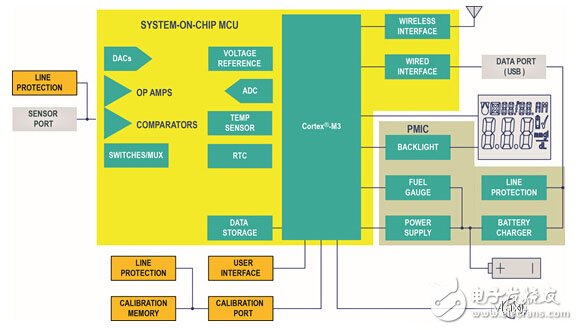introduction A high percentage of adults worldwide need to regularly monitor their vital signs (ie, blood sugar, blood pressure, and oxygen saturation). Naturally, we are seeing an increasing demand for portable medical devices that can do the above tasks and even integrate more functions. And this trend will not stop. Volume, weight, reliability, safety, and power consumption are key factors in designing modern portable medical devices. Nowadays, typical portable medical devices generally require a variety of macro modules: power management circuits for processing power supplies, whether disposable or rechargeable batteries; analog front end (AFE) for modulating and converting the signals of the sensors into digital signals; A mathematical calculation for acquiring signals, displaying information on an integrated LCD screen, or transmitting data to a wired/wireless device. Implementing all of these features typically requires the use of different discrete devices. Efficient power management is critical to these portable devices. This article describes a single-chip, low-power system-on-a-chip (SoC) that is suitable for use with portable medical devices that use disposable batteries (button cells or alkaline batteries) and for medical devices powered by rechargeable batteries. We will also discuss the second design, which adds a power management IC (PMIC) to support add-on features. Before introducing these two options, we need to first understand the typical discrete design. Then discuss the benefits of moving to an integrated solution that improves performance without affecting the power budget. We also look at new integrated circuits that save space, maximize power utilization, and increase security with USB connectivity. We'll also look at how easy it is to connect a modern portable medical device to a smartphone, and how to extend the reach of the application and use seemingly infinite data. The complexity, cost and space of a discrete solution Our discussion begins with a brief review of the typical functional block diagram of a discrete power scheme (Figure 1). Battery management circuits include battery isolators, battery chargers, fuel gauges, backlighting power supplies, and linear/switching regulators. AFEs typically require ADCs, DACs, op amps, comparators, analog switches, and voltage references. Using so many discrete devices can potentially affect system reliability while also increasing cost and board space without a doubt. Integrated solution with high performance Now, there is a new two-chip integrated solution that includes microcontroller SoCs and PMICs to improve overall performance (Figure 2). We will introduce SOC and PMIC next. Figure 2. An integrated solution using the MAX32600 microcontroller SoC and PMIC simplifies design and improves performance. Secure Medical Microcontroller SoC The MAX32600 microcontroller SoC (Figure 3) is based on Cortex 1.2mm Shelf Header Led Display LED Shelf Signage,LED Display Shelf,Digital Shelf Edge Displays,Outdoor Rental LED Display ShenZhen UHLED Technology Co., LTD. , https://www.uhled.com
Figure 1. Block diagram of a basic power scheme using a number of discrete components in a portable medical device. 
![]() The M3 core features a high-performance analog front end (AFE) that integrates advanced security and trust protection, unlike competitive power solutions. Wired and wireless communication interfaces offer a variety of options for users to connect medical devices to other portable hosts, such as PDAs or smartphones.
The M3 core features a high-performance analog front end (AFE) that integrates advanced security and trust protection, unlike competitive power solutions. Wired and wireless communication interfaces offer a variety of options for users to connect medical devices to other portable hosts, such as PDAs or smartphones. 
Figure 3. Highly integrated microcontroller SoC optimized for portable medical devices with high security with AFE and trust protection units. Wired peripherals increase system flexibility and multiple power management modes save power.